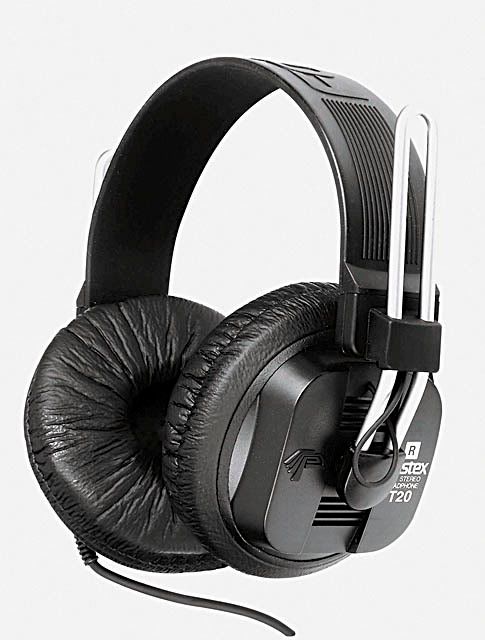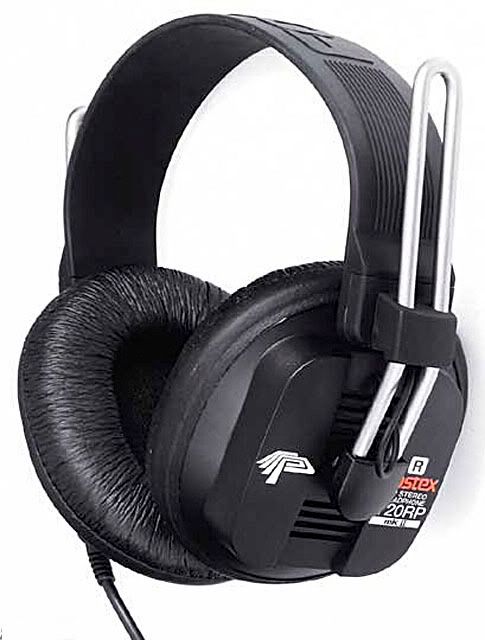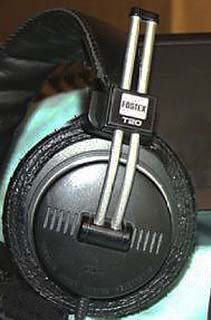[size=small]
BIG FAT UPDATE:[/size]This entire post was based on two HF members' (I'm one of them) extensive experience with the T50RP, both bought not long after the model was introduced, back in 2002. Recently (Nov '08), HF member Faust2D took one for the team and bought a new T50RP and discovered... you guessed it, Fostex improved it to the point where it's not perfect but it finally has BASS! Wow!
How did they perform this miracle?
They changed the earpads. Let me repeat that: all they did was change the earpads. The originals were stiff but very light and were covered with a nice thin supple textured pleather that felt dry, like paper. Apparently there was a durability problem with those earpads, and it could just be that people complained about the lack of bass as well; in any case, the new-production T50RP (or T50RPn, as some Japanese sites call it) can be distinguished by its roundish, flatter, shinier earpads:
[size=xx-small]
PHOTO BY FAUST2D[/size]
It further appears that Fostex has put the new pads on the T20RP Mk II and T40RP Mk II... which we were used to thinking of as pure bassless evil. That's not the case anymore. The new pads have given the previously shunned Mk II models a new audiophile life. So now, effectively, there are
four T20s and
three T40s...
Oy. In case you were wondering, all three current models use similar but not identical earpads, and they are interchangeable.
So which is better? the newly-rehabilitated mk II square drivers or the previous-generation 45mm round drivers? The rounds are certainly easier to manipulate
in situ, but many have said they prefer the more neutral (to them) sound of the new-age driver-- after extensive mods, of course. Try both. The investment won't be high.
For historical reference, I'll leave the rest of this post as it was (with some brief notes), because that's how things were in 2007. Now it's a whole new ballgame, but don't misunderstand-- the Mk II phones still need modding to sound good. They need radical surgery to sound really good, and it's not a project for beginners or cheapskates. But for the first time they're ~acceptable right out of the box, which opens up many possibilities.
We return you now to those thrilling days of yesteryear, when Fostex was first switching over the T20 and T40 to the Mk II models. Remember, the Mk II models were shunned because they had no bass, but they had no bass because the earpads were bad. And I didn't think earpads could even
be that bad.
* * * * * * *
Quote:
Originally Posted by ericj
If the images on the boxes are to believed, it appears that the T50RP is marked "T50RP" on the earcup, which would nail it as a MKII version. The T40RP seems to be marked "T40" on the earcup, which would be older, but not oldest.
|
Ericj is correct-- but there is no "oldest" T40, just an "older" one. See below. Also, "RP" appears
somewhere on every Fostex isodynamic headphone, new or old, because that's the kind of headphones they are: RP originally stood for "Regular Phase", Fostex's name for its isodynamic headphones and microphones. So a headphone with RP on it is a Fostex-built ortho headphone. It's where the letters RP appear that's important. If the earcup says T20 or T40, just that and no more, you've got a good'un.
Let's say you want to buy a Fostex T20 or T40 and you want to make
sure you have a good'un. If you have the headphone in the flesh, no problem, because if you've got the bad'un, whoop, there it is, "mk II" silkscreened right on the 'phone, so you know right away to let out a shriek, drop that 'phone like a hot tater and run like Forrest Gump. The problem arises when dealers and auction sellers refer to the 'phones in print-- they will inevitably call both generations
T40RP or
T40-RP. Say the photograph is blurry or it's a stock photo or specs carelessly swiped from a commercial site, or from Fostex's own site. Your first question to the seller should be: which T40 is it? The seller may not even know there's a difference. You'll have to ask the right followup questions.
But wait a gol-danged minute. Why, pray tell, should you avoid the mkii generation so gol-danged assiduously? Because the mkii driver is tiny (a 35mm square) and has a shaped response that gives great clarity but very suppressed bass, and treble that's great for detecting distortion, compression artifacts and hiss but which is not meant for listening to music. In other words, it's a rugged professional tool, not an audiophile's beau ideal. Let's back up a sec and look at the big Fostex picture:
* * * * * * * * * * * * * * * * * * * * * * * * * *
[size=medium]AN ABRIDGED FOSTEX CHRONOLOGY:[/size]
There was only one T10. The cheapest of the original 1978 lineup, it sounded good, better than the T20, but is so obscure we won't discuss it further here. Not a tragedy, since there are other isodynamics that sound as good or better once they're modded.
There were three T20s:
1) the old (the flat "Mickey Mouse" earpad style-- call it
T20v1 for "version one"-- made from '77 to '86. See Tyre's photos in post 15. No silkscreened printing anywhere on the 'phone's cups.
2) the middle (says "T20" on 'phone)--
T20v2. Made from '87 to 2006, with more or less the same driver as before but with a completely redesigned chassis. Arguably better sounding than its predecessor and far better sounding in stock form than its successor. Confusingly, the box for this 'phone calls it a "T20RP". You won't find this printed or molded anywhere on the 'phone itself, just "T20".
3) the new (says "T20RP" with "mk II" just below it on the 'phone)--
T20v3 ? [Nah. Since the box matches the product and the innards are so different, you'll now see this headphone referred to by Fostex's name:
T20RP mkII ]. New advanced 35mm square driver in a chassis which is almost no different from before and even less suited to the new driver (from an audiophile perspective, at least). Currently in production.
See the photos of the latter two below.
There was only one T30. Like the T10, these are hard to find.
There were two T40s. Since there was no T40 in the original 1978 lineup, there's only the middle one, circa 1990 (aka
T40v1), with a round driver, and the new one, labeled "
T40RP mk II" (infrequently called the
T40v2), with a square driver. These look very much like the corresponding T20v2 and v3.
Interesting side note: the original T40 was introduced about 4 years after the introduction of the new T20v2 because of customer demand for a truly closed headphone.
There were two North American market T50s: the unfortunately rare original from 1978 until about 1986, and the much later (2002) T50RP, which has a mkii style driver even though it isn't labeled as such. These are so different that despite the confusing name similarity and shared operating principle, they are
completely different headphones. In the ~16 years between these two, there was.... nothing.
Well, almost nothing. You should know that Foster Radio of Japan (the parent company) was and is one of the biggest and busiest OEMs ever, and that in the 1980 Fostex catalog there appears a T50 with minor differences, a T50 we are calling the "v2"-- only one example has surfaced. There were also several OEM versions of the T50, the most common of which was the NAD RP 18. There were also T50-based OEM 'phones, eg the Sansui SS-100. Just be aware that if you ever see something that looks like a T50 but has a single plastic headband instead of a two-piece leather-covered headband, it's not the same NA-market T50 I've been raving about. It may be wonderful and you may like it, but it's not the same.
UPDATE:
The many NAD RP 18s that eventually came out of the euro woodwork -- in two flavors!-- changed the rarity situation considerably, and it turns out there were Fostex T50s, and variants thereof, being sold three years before the NA introduction. We call these T50v0.
* * * * * * * * * * * * * * * * * * * * * * *
The danger these days is that you or the seller will confuse the good T20v2 with the tinny-sounding T20RP mk II (we could call it the T20v3, but it's really a different headphone), and the good T40v1 with the likewise meh-sounding T40RP mk II (ditto).
Don't lose heart. You
can tell the edible from the poisonous. Let me illustrate with the T20-- the T40 looks the same, with minor earpad cross-section differences (T40 earpad looks like a
black Krispy Kreme doughnut.)
Good T20v2 on the left. Bad new T20v3 on the right. The big differences are the shape of the earpads and the labeling. Just as red is a color to avoid when purchasing a new frog, let it be a warning to prospective T20 and T40 owners. Graphics on good T40s are a cheery, soothing yellow.
So-- ask about the shape of the earpads (circular=good). Can you rotate them on the baffle easily? (that's good too). Ask whether there are any red graphics on the earcup (red=bad), and whether the name on the earcup says "T40" or "T40RP" ("T40" is good). If that isn't enough, you can ask if "
mk II" appears anywhere on the phone-- if it does, shriek, drop, and run!)-- and / or whether the stylized molded-in RP logo is black or white. White is bad. Carefully study the photos below. The 'phones you save may be your own.
Now that you can tell a good T40 (or T20) from its evil twin, why would you even want one of these two Fostex headphones?
One, unlike many other old isodynamics and Orthodynamics, including the oldest Fosteces, the T20v2 and T40v1 are available, and as of this writing, still affordable.
Two, the T20v2/T40v1, like most Fostex RP 'phones, is great for tinkerers, since it's completely disassemblable. You can pull the diaphragm out, look at it all you want, then clamp it back in the magnet sandwich with no harm done. Try that with a dynamic! Thanks again to RedLeader for showing us this.
Three, the T20v2/T40v1 has a driver with decent-size (45mm) unconstrained diaphragm that puts out some more-than-decent bass when properly damped. Experiments ongoing-- see the
Orthodynamic Roundup thread. Once damped, they take bass boost and considerable power very well.
Three, they're a rugged,well-made isodynamic 'phone with a sound halfway between a good dynamic and an electrostat. With some thoughtful tinkering, it can be pushed further in the 'stat direction. The easy mod for the T40v1 gives it a very 'statlike sound. The less-easily modded T20v2 is arguably even better, though different in character.
Four, I think that overall, they're the isodynamics someone new to isodynamics should start with, more even than the Yamahas. Just don't expect them to sound like Stax Lambdas without doing some work on them first. And maybe not even then, since after all they're basically closed-back 'phones.
AFTERWORD:
Just to show that isodynamic drivers are inherently bitchen and awesome, you
can EQ a mkii driver to have bass, and it's good bass, but you wouldn't believe how much boost you have to bung in, and most home audio gear can't supply it. So it's best not to think about it. But the amazing little driver will take it and not blow up. For all its faults as an audiophile device, the mkii driver still has the clarity and coherence of a good planar. It's just that you wouldn't want to listen to music on it, and transplanting it to another headphone is strictly for the advanced DIYer.
[UPDATE: for the definition of "advanced DIYer", see posts in the Orthodynamic Roundup thread by Smeggy, specifically the ones where he transplants the T50RP driver into custom wooden cups and calls the result Thunderpants.]




